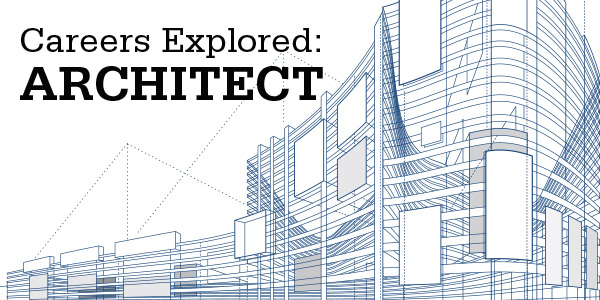Careers explored: Architect

If you appreciate the buildings that surround you, becoming an architect might be a career that interests you. Being an architect blends together art and science in order to design buildings that have purpose, whilst also being aesthetically pleasing.
Whether it is creating designs for a new construction project, extensions, alterations or redevelopments, an architect is a vital part of the process because of their specialist construction knowledge and high-level drawing skills.
Often, architects will find themselves adapting their plans during the project to meet budget constraints, environmental factors and of course, the customer’s needs. They will also work closely with other professionals who are working on the job, this includes quantity surveyors and building services engineers. Having excellent communication and organisational skills is vital, whilst an understanding in engineering, planning permissions and building regulations is an advantage.
James Tartt, director of Group D Architects and esteemed Educate Awards judge, always had an interest in design throughout his time at school and college and went on to study architecture at Liverpool John Moores University (LJMU).
He said: “I wanted to utilise my design skills in a way that could benefit the environment, society and people and also in a way that would give me a sense of pride in what I do. I would say living in Liverpool throughout the ‘noughties’ inspired me too. Seeing Liverpool gain Capital of Culture status in 2008 and watching the city progress and transform made me want to be a part of its exciting resurgence.”
In the UK, architecture is a regulated profession. This means that you must be registered with the Architects Registration Board (ARB) to practice using the title ‘architect’. Membership of a professional body is optional but not a substitute for registration.
Becoming an architect takes a lot of hard work and dedication. In the past, completing a degree at university would have been the main route into the profession but there are now apprenticeships available.
If you choose the university route, you will firstly need to complete a three-year degree in architecture – this is often referred to as ‘Part 1’. Following this, you must gain a year’s professional experience.
Next, you will need to conduct a two year degree or diploma in architecture – this is usually referred to as ‘Part 2’. Once again, this is followed by a further year of professional experience.
Finally, you then need to take the Professional Practice Examination – this is known as ‘Part 3’. You will need to have all three qualifications in order to apply for registration, together with a minimum of 24 months appropriate practical training experience.
Whilst gaining experience you will be earning a salary. As a Part 1 architectural assistant, you are likely to achieve between £15,000 – £22,000 per year, depending on location.
As a Part 2 architectural assistant, you will have gained some valuable experience and could receive between £23,000 – £35,000 per year.
As a fully qualified (Part 3) architect, you could earn between £32,000 and £45,000, depending on your experience.
LJMU’s BA (Hons) Architecture degree requires applicants to have obtained grade C or grade 4 or above in English Language/mathematics and science GCSE or an approved alternative qualification.
You will also need a minimum of three relevant A-levels, achieving ABB. Or for T-levels a minimum of 128 UCAS points in a relevant subject. BTEC qualifications are also considered when combined with other qualifications.
The three-year course is accredited by RIBA and the ARB (Architects Registration Board) and gives students the opportunity to work on a range of authentic architectural projects with input from practicing architects in a dynamic studio environment with access industry standard technical facilities.
If university isn’t the route for you, why not look at an architecture apprenticeship. An apprenticeship combines hands-on experience and academic training from a university, whilst earning a salary – you won’t have to pay for your academic tuition either!
Currently these apprenticeships are only available in England and these are split into two levels: a Level 6 Architectural Assistant apprenticeship includes a Part 1 degree qualification, and a Level 7 Architect Apprenticeship includes both the Part 2 and Part 3 qualifications.
They can take around four years to complete and you’re likely to need a CV, portfolio and qualifications equivalent to 5 GCSEs and 3 A-levels. You can find what apprenticeships are available here: www.findapprenticeship.service.gov.uk.
Once James achieved his degree, he worked at a practice in Liverpool for six years, before moving on to form his own new businesses, Group D Architects & Group D Developments.
James has had the opportunity to work across a range of exciting projects around the North West and he particularly enjoys working with clients who also have a passion for design.
He explains: “I love working with enthusiastic clients that care for good design and are willing to strive for the very best results. If people have the right mindset, enthusiasm and energy, the end result/buildings we create are more often than not a joy to work on and the building themselves benefit from this too.
“I’ve worked on everything from highend homes, to an arts village/centre, to a skyscraper on Liverpool’s waterfront. I suppose my favourite job so far though was working on an amazing high-end home for really lovely clients in Egerton, near Bolton. There were no limits on what the client wanted to achieve with their project, and they gave us free rein to really express ours and their own design aspirations.”
However, there can be lots of pressures in this line of work as you have a high level of responsibility for the projects that you work on.
James shares some insight and says: “The architecture/construction industry is not an easy game to be involved with. Whilst it can be a rewarding profession, it does present many challenges. We are lead designer on projects, so we are responsible for the coordination of many different disciplines such as structural engineers, mechanical engineers, builders, so we are often viewed as mediators on projects. I’d say the biggest challenges are being flexible, adaptable, reactive and being good with people – to ensure we maintain harmony within teams for smooth running of projects.
“The working hours within architecture are sometimes long and hard and we often work to tight deadlines. But as long as you are aware of this and you are prepared and learn to organise your time well, the job can be a rewarding one.”
Over the years, James has met and worked with many graduates who are hungry to excel in their career. But what makes a graduate standout from the crowd?
Ultimately future members of Group D should be pleasant to work with, enthusiastic team players, and good with people, therefore very personable. We find if people have these ingredients to begin with, then they are generally great candidates – things such as technical skills, knowledge and professionalism can be taught and attained.”
He says: “Enthusiasm! Skills are great, but skills can be learned. We love people with energy, drive and enthusiasm to achieve and progress.
Finally, James offers this useful piece of advice to anyone thinking of becoming an architect.
He concludes: “Value your skills! I think a lot of people in the industry are guilty of forgetting that we spend a lot of time at university and spend a lot of money investing in our education and forget that we bring a lot to the table to assist making projects a reality. Value this, value your time and make sure that you are valued, whether this be by your employer or clients!”
Want to study Architecture?
UCAS code: K100
Minimum points required from qualifications: 128
Location: At the RIBA award-winning, purpose-built John Lennon Art and Design Building
All short-listed applicants are requested to submit a digital portfolio
Find out more: www.ljmu.ac.uk/study/courses/
Did you know?
You must register with the statutory body, the Architects Registration Board (ARB), in order to legally use the title ‘architect’ in the UK.






